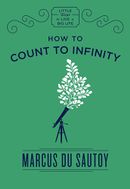
by Marcus Du Sautoy
Copied from the European Mathematical Society
Reviewer: Adhemar Bulheel
Marcus Du Sautoy starts with an introduction formulating the following problem. If you want to count to infinity by enumeration: 1,2,3,…, you will never be able to reach infinity, no matter how fast you will count. So is it possible to count to infinity? To start with the beginning: counting is one of the earliest human “mathematical” activities. However, a sum of infinitely many numbers can still be finite. Suppose you count the first ten numbers at a slow pace, but with every subsequent 10 numbers you count twice as fast, then he proves that you will reach infinity in a finite time. But that requires you to eventually count infinitely fast. Some primitive languages have words for one, two and three, but everything beyond is “many”. However these people can still work out whether a set with more than three elements is bigger or smaller than another set. The method is pairing the elements one by one and the bigger set will have elements that cannot be paired with elements of the smaller set. This pairing idea is used in the metaphor of the Hilbert hotel to illustrate that there are as many rational numbers as natural numbers. Then Du Sautoy illustrates that people needed irrational numbers like for example the square root of 2 and pi. With Cantor’s diagonal principle he can illustrate that there are more irrational numbers than rationals. And there we are: we reached infinity and even went beyond to a next level. Du Sautoy concludes: “The trick was not to start counting, ‘1,2,3,’ and then to hope to reach infinity. Instead, a change of perspective allowed us to think of infinity in one go and, by doing so, to show that infinity is a many-headed beast. Amazingly it took just 48 pages for us to get to infinity. That’s the power of mathematical thought. Using our finite equipment in our head we can transcend our finite surroundings and touch the infinite”, a poetical ode to mathematics.
If you want to know what mathematicians mean when they talk about infinity. Why is infinity plus one or even two times infinity not bigger than infinity? How to compare two sets that both have infinitely many elements? Is it then still possible that one of them is bigger than the other? If you are confronted with this kind of questions and you ignore the answers, then you have no more excuse. This little booklet has all the answers, and the great news is that you don’t need to know any mathematics for that, and it takes not more than a jiffy to finish. So, what are you waiting for?
Facts:
English title: How to Count to Infinity
Original title: How to Count to Infinity
Published: 2017
